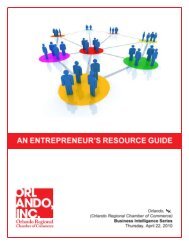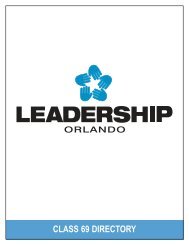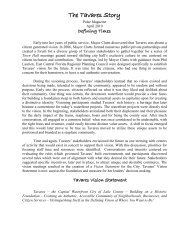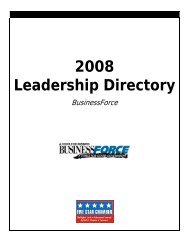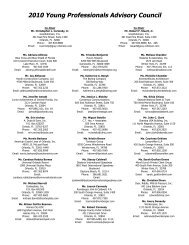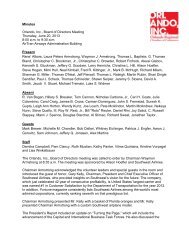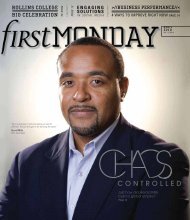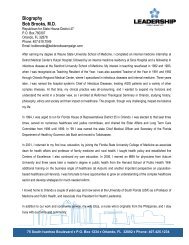FM Oct 04 PDF - Orlando Chamber of Commerce
FM Oct 04 PDF - Orlando Chamber of Commerce
FM Oct 04 PDF - Orlando Chamber of Commerce
Create successful ePaper yourself
Turn your PDF publications into a flip-book with our unique Google optimized e-Paper software.
BUSINESS & TECHNOLOGY<br />
Bobo No More<br />
Even good intentions can lead to a failed small business venture.<br />
By Sara Brady, Chair, Small Business <strong>Chamber</strong>, Wragg & Casas Public Relations<br />
Good things come in small packages<br />
and in cages. At least that’s probably<br />
how life seemed to Steve “Tarzan”<br />
Sipek, the man who raised Bobo, the<br />
600-pound tiger who took a trot on<br />
the wild side and ended up buried<br />
under the concrete jungle known as<br />
South Florida.<br />
At first and from a distance, the<br />
story about the lost tiger was amusing<br />
because it’s just not all that uncommon<br />
to hear about dangerous beasts running<br />
loose in Florida. After all, Carl Hiaasen<br />
didn’t become a bestselling author by<br />
writing about activities in Wisconsin.<br />
What’s really interesting is the<br />
“business” <strong>of</strong> Bobo. Bobo the Tiger was<br />
the symbol <strong>of</strong> Tarzan Sipek’s mission<br />
to protect and care for discarded wild<br />
animals in the compound he designed<br />
and has operated since the 1970s. It<br />
seems to have started out as a small<br />
not-for pr<strong>of</strong>it entity with the grand<br />
and noble objective <strong>of</strong><br />
protecting dangerous and<br />
unwanted animals.<br />
Indeed, Bobo was a<br />
beautiful example <strong>of</strong> a species<br />
in need <strong>of</strong> protection. But from<br />
a business standpoint, he was<br />
inventory. Bobo enjoyed quite<br />
a life as top cat in Tarzan’s<br />
compound. He was free to Sara Brady<br />
stroll through Tarzan’s home<br />
and sleep in Tarzan’s bed. By all<br />
accounts, he was tabby-cat tame.<br />
Anyone can understand the sorrow<br />
that Tarzan expressed at the dramatic<br />
loss <strong>of</strong> his precious pet, and his number<br />
one attraction.<br />
According to newspaper accounts,<br />
Tarzan and his collection <strong>of</strong> lions and<br />
tigers and cougars — oh my — are<br />
legendary in Loxahatchee Groves<br />
in Palm Beach County. Visitors —<br />
in business jargon these would be<br />
“customers” — were treated to<br />
seeing well-kept happy beasts<br />
that if not able to live in the<br />
wilds <strong>of</strong> Africa, would choose<br />
Palm Beach County as their<br />
second home. Sort <strong>of</strong> like<br />
the Rockefellers.<br />
Bobo’s value was in his<br />
celebrity. He was known to<br />
and was beloved by everyone.<br />
Mournful neighbors’ gushing<br />
in sorrow made their other<br />
celebrity resident — Ted Kennedy —<br />
look like the more ferocious beast. In<br />
spite <strong>of</strong> one account that Bobo had<br />
attacked a visitor, no one seemed to<br />
care because it was the visitor’s fault.<br />
Apparently no blame was directed<br />
at Tarzan for failing to properly manage<br />
his product line. There are no reports<br />
that he tried to warn the victim <strong>of</strong><br />
impending danger by belting out that<br />
bloodcurdling call <strong>of</strong> the wild <strong>of</strong>ten<br />
executed when swinging from vine<br />
to vine.<br />
Regardless, Tarzan represents<br />
the small business owner. He chose<br />
something he cared about deeply. He<br />
put his heart and soul into his work<br />
and had a very small staff. He adhered<br />
to proper licensing and permitting<br />
requirements associated with his<br />
unique animal kingdom.<br />
Business owners know that these<br />
factors are the very essence <strong>of</strong> running<br />
a small business. So it’s more than fair<br />
to say that the very nature <strong>of</strong> his mission<br />
makes him a risk taker. It was a risk that<br />
was a success for a long time, until one<br />
incident triggered a series <strong>of</strong> events that<br />
cost him plenty.<br />
What’s the moral to Tarzan Sipek’s<br />
entrepreneurial effort?<br />
It’s a jungle out there.<br />
Participative Management<br />
Employees become more engaged in future development <strong>of</strong> companies.<br />
By Paul DePalma, President and Founder, BusinessWorks, Inc.<br />
“Change is debilitating when it is<br />
done to us, exhilarating when it is<br />
done by us.”<br />
— Rosabeth Moss Kanter<br />
Developing a company’s strategy<br />
used to be the exclusive privilege <strong>of</strong><br />
the executive suite. Only a company’s<br />
senior leaders were thought to have<br />
the knowledge and status to determine<br />
the key objectives <strong>of</strong> the organization<br />
and its future.<br />
Locked in conference rooms or<br />
traveling to cloistered retreats, they<br />
would decide the company’s future.<br />
Crafting it on flip charts, they would<br />
return to the troops like Moses coming<br />
down the mountain with his tablets,<br />
announcing their decisions. But unlike<br />
Moses, these executives did not receive<br />
the word from on high. They aren’t<br />
all-seeing and all-knowing about their<br />
company. In fact, senior leaders are<br />
<strong>of</strong>ten furthest removed from crucial<br />
input for developing strategy such as<br />
environmental impact and customers’<br />
requirements.<br />
To create strategy more effectively,<br />
many companies are moving toward a<br />
participative management model where<br />
employees at all levels are engaged in<br />
the development <strong>of</strong> the organization’s<br />
plans for the future. Participative management<br />
is proving to be beneficial for a<br />
number <strong>of</strong> reasons.<br />
Crafting it on flip charts, they<br />
would return to the troops<br />
like Moses coming down the<br />
mountain with his tablets,<br />
announcing their decisions.<br />
Employees who feel that they can<br />
contribute are more connected to the<br />
goals <strong>of</strong> the organization.<br />
Participation builds trust between<br />
senior leaders and employees. This<br />
accelerates when leaders listen to and<br />
use suggestions from employees and<br />
then recognize their contributions.<br />
Employees are much more committed<br />
to supporting changes if they have<br />
a hand in creating them. With the<br />
business environment changing rapidly,<br />
organizations need to adapt consistently<br />
to stay competitive.<br />
Employees involved in creating<br />
company strategy learn the processes<br />
and methods <strong>of</strong> working on the<br />
business. Employees who think about<br />
how to improve what they do tend to<br />
be pioneers in finding efficiencies to<br />
improve performance, a critical factor<br />
in strong organizations.<br />
Whether it’s called employee<br />
involvement, participative management,<br />
or some other phrase, employee input<br />
at all levels <strong>of</strong> the organization is a<br />
powerful method for creating a solid<br />
company strategy and thereby a better<br />
future for the organization.<br />
There’s nothing wrong with senior<br />
leaders going on a retreat to plan<br />
strategy. Just don’t leave all the other<br />
employees and their ideas at home.<br />
For more, contact Paul DePalma<br />
at 407-660-5757 or via e-mail at<br />
paul@businessworks-inc.com. Access<br />
the BusinessWorks Inc. Web Site at<br />
www.businessworks-inc.com.<br />
Since 1992, BusinessWorks has helped both<br />
for-pr<strong>of</strong>it and not-for-pr<strong>of</strong>it organizations<br />
optimize human dynamics for improved<br />
business performance. The company uses<br />
proven organization development methodologies<br />
to help companies analyze and<br />
improve how to produce results through<br />
the planned development and reinforcement<br />
<strong>of</strong> the organizations strategies and<br />
structures; systems and processes; and<br />
dynamics and culture.<br />
16 OCTOBER 20<strong>04</strong> <strong>FM</strong>



